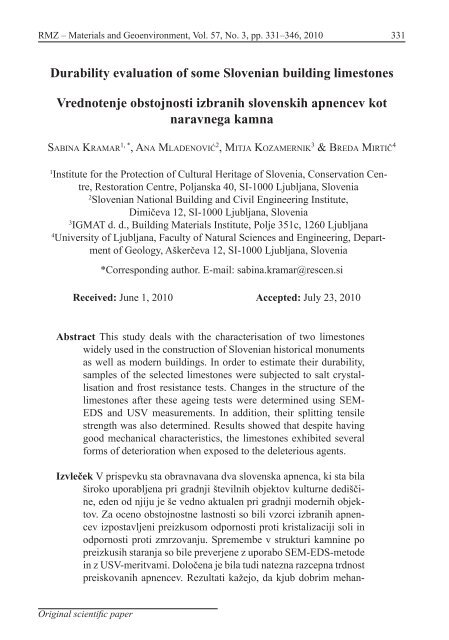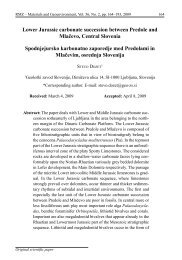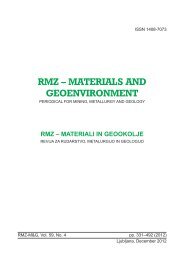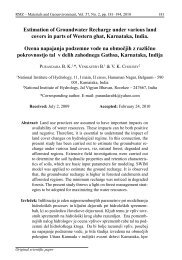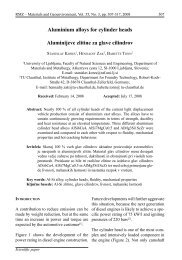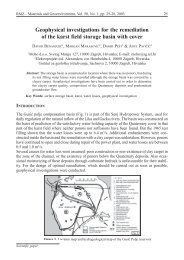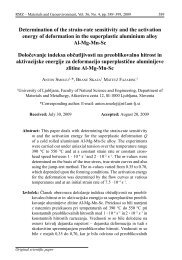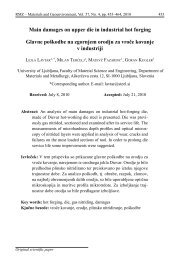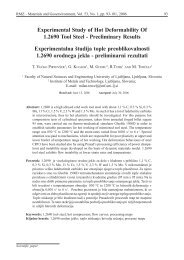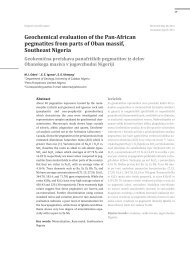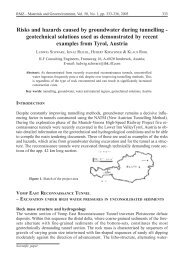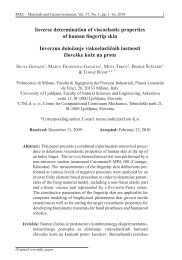Durability evaluation of some Slovenian building limestones ... - RMZ
Durability evaluation of some Slovenian building limestones ... - RMZ
Durability evaluation of some Slovenian building limestones ... - RMZ
Create successful ePaper yourself
Turn your PDF publications into a flip-book with our unique Google optimized e-Paper software.
<strong>RMZ</strong> – Materials and Geoenvironment, Vol. 57, No. 3, pp. 331–346, 2010<br />
331<br />
<strong>Durability</strong> <strong>evaluation</strong> <strong>of</strong> <strong>some</strong> <strong>Slovenian</strong> <strong>building</strong> <strong>limestones</strong><br />
Vrednotenje obstojnosti izbranih slovenskih apnencev kot<br />
naravnega kamna<br />
Sabina Kramar 1, * , Ana Mladenović 2 , Mitja Kozamernik 3 & Breda Mirtič 4<br />
1<br />
Institute for the Protection <strong>of</strong> Cultural Heritage <strong>of</strong> Slovenia, Conservation Centre,<br />
Restoration Centre, Poljanska 40, SI-1000 Ljubljana, Slovenia<br />
2<br />
<strong>Slovenian</strong> National Building and Civil Engineering Institute,<br />
Dimičeva 12, SI-1000 Ljubljana, Slovenia<br />
3<br />
IGMAT d. d., Building Materials Institute, Polje 351c, 1260 Ljubljana<br />
4<br />
University <strong>of</strong> Ljubljana, Faculty <strong>of</strong> Natural Sciences and Engineering, Department<br />
<strong>of</strong> Geology, Aškerčeva 12, SI-1000 Ljubljana, Slovenia<br />
*Corresponding author. E-mail: sabina.kramar@rescen.si<br />
Received: June 1, 2010 Accepted: July 23, 2010<br />
Abstract This study deals with the characterisation <strong>of</strong> two <strong>limestones</strong><br />
widely used in the construction <strong>of</strong> <strong>Slovenian</strong> historical monuments<br />
as well as modern <strong>building</strong>s. In order to estimate their durability,<br />
samples <strong>of</strong> the selected <strong>limestones</strong> were subjected to salt crystallisation<br />
and frost resistance tests. Changes in the structure <strong>of</strong> the<br />
<strong>limestones</strong> after these ageing tests were determined using SEM-<br />
EDS and USV measurements. In addition, their splitting tensile<br />
strength was also determined. Results showed that despite having<br />
good mechanical characteristics, the <strong>limestones</strong> exhibited several<br />
forms <strong>of</strong> deterioration when exposed to the deleterious agents.<br />
Izvleček V prispevku sta obravnavana dva slovenska apnenca, ki sta bila<br />
široko uporabljena pri gradnji številnih objektov kulturne dediščine,<br />
eden od njiju je še vedno aktualen pri gradnji modernih objektov.<br />
Za oceno obstojnostne lastnosti so bili vzorci izbranih apnencev<br />
izpostavljeni preizkusom odpornosti proti kristalizaciji soli in<br />
odpornosti proti zmrzovanju. Spremembe v strukturi kamnine po<br />
preizkusih staranja so bile preverjene z uporabo SEM-EDS-metode<br />
in z USV-meritvami. Določena je bila tudi natezna razcepna trdnost<br />
preiskovanih apnencev. Rezultati kažejo, da kjub dobrim mehan-<br />
Original scientific paper
332 Kramar, S., Mladenović, A., Kozamernik, M. & Mirtič, B.<br />
Since prehistoric times, limestone has<br />
been one <strong>of</strong> the most popular types<br />
<strong>of</strong> <strong>building</strong> stone and is today used in<br />
both the construction <strong>of</strong> modern <strong>building</strong>s<br />
and in conservation as a replacement<br />
material for the reconstruction<br />
<strong>of</strong> monuments. All stone used in these<br />
applications eventually changes due to<br />
their interaction with the various environmental<br />
conditions to which they are<br />
subjected. Although limestone consists<br />
mainly <strong>of</strong> calcite, it can show significant<br />
variation in composition in terms<br />
<strong>of</strong> minor minerals, as well as structure<br />
and texture, resulting in complex and<br />
contrasting weathering behaviours<br />
(Warke et al., 2006). Among the decay<br />
factors, soluble salt crystallisation is<br />
considered to be one <strong>of</strong> the most powerful<br />
affecting the weathering <strong>of</strong> carbonate<br />
stone (Charola, 2000; Doehne,<br />
2002). These salts are known to cause<br />
damage to porous materials through<br />
a variety <strong>of</strong> mechanisms, such as the<br />
production <strong>of</strong> physical stress resulting<br />
from their crystallisation in the pores,<br />
differential thermal expansion, hydraskim<br />
karakteristikam preiskovanih apnencev le-ti propadajo, ko so<br />
izpostavljeni škodljivim dejavnikom.<br />
Key words: limestone, durability, deterioration, salt crystallisation, natural<br />
stone<br />
Kjučne besede: apnenec, obstojnost, propadanje, kristalizacija soli, naravni<br />
kamen<br />
Introduction<br />
tion pressure and enhanced wet/dry<br />
cycling caused by deliquescent salts<br />
(Charola, 2000; Doehne, 2002).<br />
As many <strong>Slovenian</strong> monuments and<br />
modern <strong>building</strong>s are built <strong>of</strong> <strong>limestones</strong>,<br />
estimation <strong>of</strong> their durability<br />
is necessary for their successful maintenance,<br />
protection and proper restoration/conservation.<br />
Two <strong>Slovenian</strong><br />
<strong>limestones</strong> were selected for study: Lesno<br />
Brdo and Drenov Grič. Lesno Brdo<br />
limestone is characterised by a variety<br />
<strong>of</strong> colours: red, pink and numerous<br />
shades <strong>of</strong> light to dark grey. It has<br />
been frequently employed in the construction<br />
<strong>of</strong> <strong>Slovenian</strong> historical monuments<br />
(Mirtič et al., 1999; Ramovš,<br />
2000; Jarc, 2000), as well as in modern<br />
<strong>building</strong>s. In the past, the limestone<br />
was also used in many churches<br />
in Ljubljana, for portals or fountains<br />
(Ramovš, 2000). In modern <strong>building</strong>s<br />
it is used for cladding and flooring, or<br />
as a replacement material in the conservation<br />
and restoration <strong>of</strong> historical<br />
monuments. Drenov Grič limestone on<br />
the other hand, is dense and as such can<br />
produce a highly polished finish. As a<br />
<strong>RMZ</strong>-M&G 2010, 57
<strong>Durability</strong> <strong>evaluation</strong> <strong>of</strong> <strong>some</strong> <strong>Slovenian</strong> <strong>building</strong> <strong>limestones</strong><br />
333<br />
result it was considered as popular as<br />
marble, being widely used particularly<br />
in baroque architecture not only<br />
in Ljubljana, but also in other regions<br />
<strong>of</strong> Slovenia. Many interior and exterior<br />
architectural elements and monuments,<br />
especially the portals <strong>of</strong> houses<br />
and altars, were made <strong>of</strong> this limestone<br />
(Ramovš, 2000). However, both <strong>limestones</strong><br />
are at risk when exposed to certain<br />
climatic conditions, with chromatic<br />
and salt weathering recognised as the<br />
phenomena most responsible for their<br />
deterioration (Kramar et al., 2010a;<br />
Kramar et al., 2010b).<br />
In order to estimate the weathering<br />
behaviour <strong>of</strong> the selected <strong>limestones</strong>,<br />
samples were subjected to the salt crystallisation<br />
test and freeze/thaw cycles.<br />
Changes in the mechanical-physical<br />
properties <strong>of</strong> the <strong>limestones</strong> after these<br />
ageing tests were estimated via ultrasonic<br />
velocity measurements and SEM<br />
examination. In addition, the splitting<br />
tensile strength <strong>of</strong> the fresh <strong>limestones</strong><br />
was also determined.<br />
Materials and methods<br />
Materials<br />
For the study, two <strong>Slovenian</strong> <strong>limestones</strong><br />
were selected; Lesno Brdo and<br />
Drenov Grič. Samples <strong>of</strong> Drenov Grič<br />
limestone (DG) were collected from<br />
the main quarry in Drenov Grič near<br />
Ljubljana (Figure 1a), which historically<br />
had a leading role in supplying<br />
<strong>building</strong> material to central parts <strong>of</strong><br />
Slovenia (Ramovš, 2000). This Triassic<br />
well-stratified limestone occurs in<br />
10–80 cm thick beds, which alternate<br />
with thin sheets <strong>of</strong> marls. The Drenov<br />
Grič limestone is considered one <strong>of</strong> the<br />
most beautiful <strong>Slovenian</strong> natural stones<br />
due to its typical black colour interwoven<br />
with white veins (Figure 1b). Fragments<br />
<strong>of</strong> fossil bivalvia, gastropoda, algae,<br />
foraminifera, ostracods and corals<br />
are also occasionally found (Ramovš,<br />
2000). Samples <strong>of</strong> Lesno Brdo limestone<br />
were taken from the still active<br />
local quarry <strong>of</strong> Lesno Brdo near Ljubljana<br />
(Figure 2a). Two lithotypes <strong>of</strong><br />
this Triassic reef limestone were selected:<br />
the dark grey lithotype – SLB<br />
(Figure 2b) and the light red lithotype<br />
- PLB (Figure 2c). Lesno Brdo limestone<br />
is heterogeneous, composed <strong>of</strong><br />
intraclasts, pellets and fossil fragments.<br />
Coloured (violet, red, green and white)<br />
veins and styloliths filled with phyllosilicates<br />
or iron oxides/hydroxides are<br />
also present, along with large yellow<br />
or violet dolomite crystals (Ramovš,<br />
2000).<br />
Analytical methods<br />
Analysis <strong>of</strong> the <strong>limestones</strong>’ splitting tensile<br />
strength was performed according to<br />
SIST EN 12390-6, using a ZWICK apparatus<br />
b24, type Z 400 E. Samples took<br />
the form <strong>of</strong> (50 × 50 × 50) mm cubes,<br />
<strong>RMZ</strong>-M&G 2010, 57
334 Kramar, S., Mladenović, A., Kozamernik, M. & Mirtič, B.<br />
Figure 1. a) Historical Drenov Grič limestone quarry. b) Polished surface<br />
<strong>of</strong> Drenov Grič limestone. Image is about 4 cm in size.<br />
Figure 2. a) Active Lesno Brdo limestone quarry. b) Polished surface <strong>of</strong><br />
the grey lithotype <strong>of</strong> Lesno Brdo limestone. Image is about 4 cm in size.<br />
c) Polished surface <strong>of</strong> the red lithotype <strong>of</strong> Lesno Brdo limestone. Image is<br />
about 4 cm in size.<br />
with three taken from each limestone<br />
lithotype. Measurements were performed<br />
on dry as well as water-saturated<br />
samples (water immersion undertaken<br />
according to SIST EN 1936).<br />
The salt crystallisation test (SIST EN<br />
12370) and the determination <strong>of</strong> frost<br />
resistance (SIST EN 12371) were carried<br />
out on (50 × 50 × 50) mm cubes<br />
in order to provide information as to<br />
<strong>RMZ</strong>-M&G 2010, 57
<strong>Durability</strong> <strong>evaluation</strong> <strong>of</strong> <strong>some</strong> <strong>Slovenian</strong> <strong>building</strong> <strong>limestones</strong><br />
335<br />
their damaging effect. After the frost<br />
resistance test, limestone loss <strong>of</strong> mass<br />
Vb48 was determined. Changes in microstructure<br />
were observed using SEM-<br />
EDX and USV after 15 immersions in<br />
Na-sulphate and 48 freeze-thaw cycles.<br />
Cross-sections <strong>of</strong> the weathered limestone<br />
samples were examined under a<br />
Scanning Electron Microscope (JEOL<br />
5600 LV), using the low vacuum backscattered<br />
electrons (BSE) imaging<br />
mode. Some areas <strong>of</strong> the samples were<br />
analysed for chemical composition using<br />
the energy dispersive X-ray technique<br />
(EDS).<br />
In order to determine changes in the<br />
mechanical-physical properties <strong>of</strong> the<br />
samples after the ageing procedures<br />
were carried out, ultrasonic velocity<br />
measurements were performed in three<br />
directions using an AU 2000 Ultrasonic<br />
Tester (CEBTP) with a transmission<br />
frequency <strong>of</strong> 60 kHz. Speed <strong>of</strong> sound<br />
wave propagation was undertaken according<br />
to standard procedure EN<br />
14579. Three measurements were performed<br />
in each <strong>of</strong> the three orthogonal<br />
directions. Additionally, the total structural<br />
anisotropy coefficient ΔM/% and<br />
relative anisotropy coefficient Δm/%<br />
<strong>of</strong> the samples were obtained from the<br />
mathematical relationship between the<br />
ultrasonic propagation velocities, following<br />
the equations <strong>of</strong> Guydader &<br />
Denis (1986):<br />
a) total anisotropy:<br />
ΔM/% = 100 [1 – (2 V L1<br />
/V L2<br />
+ V L3<br />
)] (1)<br />
b) relative anisotropy:<br />
Δ m% = 100 [2 (V L2<br />
- V L3<br />
)/V L2<br />
+ V L3<br />
] (2)<br />
where V L1<br />
is the lowest and V L2<br />
the<br />
highest measured velocity.<br />
The degree <strong>of</strong> weathering can be calculated<br />
through the reduction <strong>of</strong> longitudinal<br />
wave velocity (Zezza & Veinale,<br />
1988) from unweathered (V 0<br />
) to weathered<br />
(V w<br />
) stone samples:<br />
K = (V 0<br />
- V w<br />
)/V 0<br />
or ΔV(L)% =<br />
100 (V 0<br />
- V w<br />
)/V 0<br />
(3)<br />
USV measurements were carried out<br />
both before and after the salt crystallisation<br />
(on unwashed and washed specimens)<br />
and frost resistance tests.<br />
Results and discussion<br />
Splitting tensile strength<br />
As can be seen from Table 1, all three<br />
<strong>limestones</strong> exhibited high values <strong>of</strong><br />
splitting tensile strength, although levels<br />
slightly differed between each one.<br />
The highest strength was observed in<br />
the grey lithotype <strong>of</strong> the Lesno Brdo<br />
limestone, followed by Drenov Grič<br />
limestone and the red Lesno Brdo<br />
lithotype. There were no significant<br />
differences observed between the different<br />
orientations <strong>of</strong> bedding planes<br />
<strong>RMZ</strong>-M&G 2010, 57
336 Kramar, S., Mladenović, A., Kozamernik, M. & Mirtič, B.<br />
Table 1. Splitting tensile strength <strong>of</strong> the investigated <strong>limestones</strong>. Results represent three<br />
sample mean values ± standard deviation.<br />
Sample<br />
Splitting tensile strength (MPa)<br />
Drenov Grič limestone dry water-saturated<br />
(DG)<br />
^ bedding 11.70 ± 4.72 11.13 ± 3.91<br />
// bedding 13.43 ± 3.12<br />
Lesno Brdo limestone<br />
Grey lithotype<br />
(SLB) 14.22 ± 1.85 14.40 ± 4.85<br />
Red lithotype<br />
(PLB) 11.62 ± 4.57 12.72 ± 5.63<br />
in Drenov Grič limestone. Using the<br />
system <strong>of</strong> BELL (1992), all three investigated<br />
<strong>limestones</strong> can be classified<br />
as very high (3–10 MPa) to extremely<br />
high strength rock (>10 MPa). There<br />
was also no difference in splitting tensile<br />
strength between the corresponding<br />
dry and water-saturated samples <strong>of</strong><br />
each <strong>of</strong> the <strong>limestones</strong>.<br />
Analysis <strong>of</strong> the results suggests that<br />
the higher the content <strong>of</strong> clay mineralfilled<br />
discontinuities, as observed in the<br />
red Lesno Brdo lithotype (Kramar et<br />
al., 2010a) and the higher the porosity,<br />
the lower the splitting tensile strength<br />
<strong>of</strong> the limestone. In addition, the results<br />
also reveal that splitting tensile<br />
strength values are much lower than<br />
those <strong>of</strong> the salt crystallisation or ice<br />
formation pressures. Salt crystallisation<br />
is accompanied by an increase in<br />
pressure due to the formation <strong>of</strong> new<br />
mineral phases. Whereas the splitting<br />
tensile strength <strong>of</strong> the investigated<br />
<strong>limestones</strong> does not exceed 20 MPa,<br />
the crystallisation pressures <strong>of</strong> the most<br />
soluble salts range from more than 100<br />
MPa (Goudie & Viles, 1997). As a result,<br />
the occurrence <strong>of</strong> crystallisation<br />
or hydration within these rocks would<br />
lead to the disruption <strong>of</strong> the material.<br />
USV measurements<br />
Results <strong>of</strong> the ultrasonic velocity analysis<br />
are presented in Table 2. The fresh<br />
SLB samples revealed faster ultrasonic<br />
wave propagation, suggesting a greater<br />
compactness and higher mechanical<br />
resistance with respect to the PLB and<br />
DG samples. In contrast, total structural<br />
anisotropy - ΔM and relative structural<br />
anisotropy - Δm values are lower<br />
in SLB than PLB samples. The large<br />
difference between the total and relative<br />
anisotropy in the DG samples is<br />
due to the presence <strong>of</strong> bedding planes<br />
within the limestone. As ultrasound<br />
velocity increases with density, compressive<br />
strength and water saturation,<br />
<strong>RMZ</strong>-M&G 2010, 57
<strong>Durability</strong> <strong>evaluation</strong> <strong>of</strong> <strong>some</strong> <strong>Slovenian</strong> <strong>building</strong> <strong>limestones</strong><br />
337<br />
but decreases with porosity (Bouineau,<br />
1978), the results indicate the higher<br />
compactness and homogeneity <strong>of</strong> the<br />
SLB samples, followed by PLB and<br />
DG.<br />
<strong>Durability</strong><br />
Limestone samples were subjected to<br />
salt crystallisation and frost resistance<br />
tests, before subsequently being observed<br />
by SEM and undergoing sound<br />
wave propagation (USV) measurements.<br />
After these ageing tests were<br />
carried out, <strong>some</strong> changes in microstructure<br />
were observed.<br />
SEM examination <strong>of</strong> samples revealed<br />
that post-ageing test limestone deterioration<br />
was expressed as granular<br />
disintegration, fissuring or flaking.<br />
These features were observed in both<br />
lithotypes <strong>of</strong> the Lesno Brdo limestone<br />
Figure 3. SEM-BSE images <strong>of</strong> investigated <strong>limestones</strong> after the ageing<br />
tests. a) Flaking <strong>of</strong> the grey Lesno Brdo limestone lithotype after salt crystallisation.<br />
b) Flaking <strong>of</strong> the red Lesno Brdo limestone lithotype after salt<br />
crystallisation is associated with the presence <strong>of</strong> phyllosilicate-filled discontinuities.<br />
Granular disintegration can also be observed at the surface. c)<br />
Flaking <strong>of</strong> the Drenov Grič limestone after salt crystallisation. d) Deterioration<br />
along cleavage planes <strong>of</strong> the grey Lesno Brdo limestone lithotype<br />
after the frost resistance test.<br />
<strong>RMZ</strong>-M&G 2010, 57
338 Kramar, S., Mladenović, A., Kozamernik, M. & Mirtič, B.<br />
after salt crystallisation (Figure 3a).<br />
Fissuring and granular disintegration<br />
were limited to the upper 50 μm or so<br />
beyond the limestone surface, whereas<br />
flakes occurred up to a depth <strong>of</strong> around<br />
25 μm. Flaking was in <strong>some</strong> cases related<br />
to the presence <strong>of</strong> phyllosilicatefilled<br />
discontinuities, as can be seen<br />
in Figure 3b. Some samples also displayed<br />
an etched surface, probably the<br />
result <strong>of</strong> dissolution caused by the salt<br />
solutions. The coarse grained dolomite<br />
was deteriorated along cleavage planes.<br />
The area <strong>of</strong> deterioration in Drenov<br />
Grič limestone after salt crystallisation<br />
was rather deeper than that observed<br />
in both Lesno Brdo lithotypes. Flaking<br />
(Figure 3c) was observed to a depth <strong>of</strong><br />
50 μm to 100 μm from the surface, in<br />
<strong>some</strong> areas up to 200 μm. Granular disintegration<br />
was restricted to the upper<br />
20 μm <strong>of</strong> the samples.<br />
Analysis <strong>of</strong> the frost resistance test results<br />
revealed no measurable loss <strong>of</strong><br />
limestone mass, except in one DGb<br />
sample, where a small loss was observed<br />
(V b48<br />
= –0.06). Thus according<br />
to the general criteria, the <strong>limestones</strong><br />
can be considered to be highly resistant<br />
to frost action. In contrast however,<br />
SEM examination <strong>of</strong> samples revealed<br />
several deterioration phenomena. Both<br />
lithotypes <strong>of</strong> Lesno Brdo limestone<br />
were affected, with granular disintegration<br />
observed 25–80 μm under the<br />
surface, although in most cases decohesion<br />
was restricted to a depth <strong>of</strong><br />
about 50 μm. Coarse-grained dolomite<br />
degraded along cleavage planes up to<br />
25 μm below the surface (Figure 3d).<br />
In addition, Drenov Grič limestone<br />
showed a system <strong>of</strong> fissures occurring<br />
parallel to the surface at depths<br />
<strong>of</strong> up to 200 μm. Decohesion between<br />
grains was observed at depths <strong>of</strong> up to<br />
50 μm, while sparitic vein decohesion<br />
occurred even deeper, up to 200 μm below<br />
the sample surface.<br />
As seen from Table 2, there were measurable<br />
reductions in ultrasound velocity<br />
in the majority <strong>of</strong> samples before and<br />
after the crystallisation (15 immersions<br />
in Na 2<br />
SO 4<br />
) and frost resistance tests<br />
(48 cycles). A decrease in ultrasound<br />
velocity indicates the occurrence <strong>of</strong> deterioration,<br />
corroborating the observations<br />
made by SEM examination. It is<br />
also widely known that a decrease in<br />
ultrasound velocity suggests the presence<br />
<strong>of</strong> discontinuities or other obstacles<br />
within stone (Fassina et al., 1993).<br />
An increase in total structural anisotropy<br />
after the salt crystallisation and frost<br />
resistance tests was observed for all<br />
investigated <strong>limestones</strong>. Furthermore,<br />
the total structural anisotropy was always<br />
lower in unwashed compared<br />
with washed samples, suggesting that<br />
salt crystals filled the discontinuities<br />
and pores in the limestone, resulting<br />
in a temporary reduction in anisotropy<br />
(Papida et al., 2000). In general, the<br />
samples’ relative anisotropy increased<br />
<strong>RMZ</strong>-M&G 2010, 57
<strong>Durability</strong> <strong>evaluation</strong> <strong>of</strong> <strong>some</strong> <strong>Slovenian</strong> <strong>building</strong> <strong>limestones</strong><br />
339<br />
after undergoing the ageing tests. In<br />
PLB and DG samples, a decrease in<br />
relative structural anisotropy was observed<br />
in unwashed samples, probably<br />
for the same reason as described above<br />
for total structural anisotropy. These results<br />
correlate with the findings <strong>of</strong> other<br />
studies (Cultrone et al., 2008; Cardell<br />
et al., 2008), who have also reported an<br />
increase in velocity and structural anisotropy<br />
after the salt crystallisation test.<br />
The degree <strong>of</strong> weathering V/% <strong>of</strong> the<br />
samples was always higher after the<br />
salt crystallisation test compared to the<br />
frost resistance test for all investigated<br />
<strong>limestones</strong>. This is in agreement with<br />
SEM observations, where the samples<br />
always demonstrated higher damage<br />
after salt crystallisation. In terms <strong>of</strong> the<br />
salt crystallisation test alone, the degree<br />
<strong>of</strong> weathering was always higher<br />
in washed than unwashed samples.<br />
Table 2. Results <strong>of</strong> USV measurements: v1-3 = average values± standard deviation <strong>of</strong><br />
ultrasound velocities in all three orthogonal directions <strong>of</strong> the investigated <strong>limestones</strong>,<br />
ΔM (%) = total anisotropy, Δm (%) =relative anisotropy, ΔV L<br />
(%) = degree <strong>of</strong> weathering.<br />
Samples<br />
Drenov Grič limestone<br />
Salt crystallisation<br />
SIST EN 12370<br />
Frost resistance<br />
SIST EN 12371<br />
unweathered weathered unweathered weathered<br />
unwashed washed<br />
DG v1 (km/s) 4.76 ± 0.36 4.76 ± 0.46 4.77 ± 0.46 4.78 ± 0.22 4.67 ± 0.42<br />
v2 (km/s) 4.63 ± 0.54 4.58 ± 0.51 4.11 ± 0.77 4.69 ± 0.27 4.61 ± 0.26<br />
v3 (km/s) 4.22 ± 0.82 4.77 ± 0.69 4.09 ± 1.19 4.49 ± 0.06 4.54 ± 0.11<br />
ΔM p<br />
/% 10.29 ± 8.45 10.27 ± 6.91 14.09 ± 12.32 5.05 ± 3.00 6.17 ± 1.98<br />
Δm p<br />
/% 2.42 ± 3.68 7.16 ± 4.12 12.33 ± 12.33 2.08 ± 2.25 3.75 ± 2.58<br />
ΔV L<br />
/% (-) 3.98 ± 7.86 4.70 ± 5.85 0.96 ± 1.82<br />
Lesno Brdo limestone<br />
Grey lithotype<br />
SLB v1 (km/s) 5.23 ± 0.29 4.71 ± 0.49 4.73 ± 0.53 5.21±0.21 4.95 ± 0.17<br />
v2 (km/s) 5.16 ± 0.33 4.89 ± 0.55 4.98 ± 0.78 5.04±0.17 4.99 ± 0.12<br />
v3 (km/s) 5.04 ± 0.33 4.84 ± 0.27 4.69 ± 0.57 4.99±0.08 4.74 ± 0.12<br />
ΔM p<br />
/% 3.19 ± 1.96 4.71 ± 3.00 4.10 ± 2.59 2.57 ± 2.29 4.65 ± 4.27<br />
Δm p<br />
/% 1.39 ± 1.28 5.03 ± 2.17 7.26 ± 6.18 3.22 ± 2.45 2.93 ±1.52<br />
ΔV L<br />
/% 6.38 ± 3.15 6.65 ± 3.05 3.66 ± 2.31<br />
Red lithotype<br />
PLB v1 (km/s) 5.19 ± 0.21 4.42 ± 0.35 4.74 ± 0.13 4.82±0.25 4.65 ± 0.14<br />
v2 (km/s) 4.88 ± 0.39 4.73 ± 0.57 4.76 ± 0.36 4.61±0.22 4.51 ± 0.28<br />
v3 (km/s) 4.53 ± 0.64 4.66 ± 0.13 4.11 ± 0.56 4.35±0.03 4.35 ± 0.04<br />
ΔM p<br />
/% 10.29 ± 8.80 7.02 ± 5.90 15.55 ± 7.58 6.67 ± 4.93 7.18 ± 2.36<br />
Δm p<br />
/% 6.32 ± 6.80 1.42 ± 0.82 3.19 ± 2.47 4.61 ± 3.70 9.98 ± 1.17<br />
ΔV L<br />
/% 5.01 ± 9.01 6.80 ± 3.77 1.90 ± 1.78<br />
<strong>RMZ</strong>-M&G 2010, 57
340 Kramar, S., Mladenović, A., Kozamernik, M. & Mirtič, B.<br />
A negative trend was observed in the<br />
Drenov Grič limestone, suggesting<br />
that salt filled the pores and resulted in<br />
increased limestone compactness. In<br />
general, USV data reveal that the DG<br />
samples experienced the least amount<br />
<strong>of</strong> change after undergoing ageing.<br />
Sodium sulphate is one <strong>of</strong> the most important<br />
salts responsible for the damage<br />
<strong>of</strong> natural stone (Goudie and Viles,<br />
1997). At room temperature, sodium<br />
sulphate has two stable phases: thenardite<br />
(Na 2<br />
SO 4<br />
) and mirabilite (Na 2<br />
SO 4<br />
x-<br />
10H 2<br />
O), with a metastable phase represented<br />
by sodium sulphate heptahydrate<br />
(Na 2<br />
SO 4<br />
x7H 2<br />
O). The high damage<br />
potential <strong>of</strong> sodium sulphate has been<br />
studied by several authors (Schaffer,<br />
1932; Evans, 1970; Marschner, 1978;<br />
Sperling & Cooke, 1985; Goudie &<br />
Viles, 1997), with the salt also contributing<br />
to tests studying the durability<br />
<strong>of</strong> <strong>building</strong> materials (ASTM C88-90,<br />
RILEM PEM/25, SIST EN 12370).<br />
Tests involving sodium sulphate were<br />
first carried out by Brard (1828), who<br />
used a saturated solution <strong>of</strong> sodium<br />
sulphate for simulation <strong>of</strong> the frost resistance<br />
<strong>of</strong> natural stone. Since then,<br />
a similar procedure has been used in<br />
several types <strong>of</strong> accelerated ageing<br />
test, with the aim <strong>of</strong> simulating the deterioration<br />
<strong>of</strong> natural stone, concrete<br />
and other <strong>building</strong> materials (Sperling<br />
& Cooke, 1985; Kwaad, 1970; Fahey,<br />
1986; Rodríguez-Navarro et al., 2000;<br />
Benavente et al., 1999; Benavente et<br />
al., 2001; Flatt, 2002; Benavente et<br />
al., 2004; Benavente et al., 2007; Ruiz-<br />
Agudo et al., 2007; Rothert et al.,<br />
2007; Cardell et al., 2008). The choice<br />
<strong>of</strong> sodium sulphate is based mainly on<br />
two factors: (i) its frequent occurrence<br />
in objects or environments (Arnold &<br />
Zehnder, 1988; Tuncoku et al., 1993;<br />
Bromblet, 1993; Fassina et al., 1996;<br />
Laue et al., 1996) and (ii) its high damage<br />
potential.<br />
Ruiz–Agudo et al. (2007) described<br />
the occurrence <strong>of</strong> Na-sulphate crystallisation<br />
up to 3 mm under the surface<br />
<strong>of</strong> samples, resulting in flaking. A decrease<br />
in stone porosity was also reported.<br />
However, it should be emphasised<br />
that the stones analysed in that<br />
study were highly porous, with levels<br />
<strong>of</strong> more than 30 %. In this investigation<br />
on the other hand, deterioration <strong>of</strong><br />
the <strong>Slovenian</strong> <strong>limestones</strong> was restricted<br />
to a much smaller area. This fact could<br />
be ascribed to their extremely low porosity<br />
<strong>of</strong> less than 5 % (Kramar et al.,<br />
2010a). In addition, due to their high<br />
compactness, deterioration was observed<br />
only to a depth <strong>of</strong> around 200<br />
μm below the surface. Deterioration <strong>of</strong><br />
these <strong>limestones</strong> could be a result <strong>of</strong><br />
the crystallisation pressure <strong>of</strong> thenardite,<br />
which ranges from 29.2 to 196.5<br />
MPa (Winkler & Singer, 1972) and<br />
exceeds the splitting tensile strengths<br />
<strong>of</strong> the investigated <strong>limestones</strong> which<br />
are not higher than 15 MPa. With repeated<br />
cycles <strong>of</strong> salt crystallisation,<br />
<strong>RMZ</strong>-M&G 2010, 57
<strong>Durability</strong> <strong>evaluation</strong> <strong>of</strong> <strong>some</strong> <strong>Slovenian</strong> <strong>building</strong> <strong>limestones</strong><br />
341<br />
hydration pressure also develops. The<br />
crystallisation pressure <strong>of</strong> thenardite is<br />
higher than that <strong>of</strong> mirabilite (Winker<br />
& Singer, 1972), resulting in greater<br />
damage. The transition <strong>of</strong> mirabilite to<br />
thenardite is also accompanied by an<br />
increase in volume <strong>of</strong> 300 % (Price &<br />
Brimblecombe, 1994).<br />
One factor which could have influenced<br />
the smaller amount <strong>of</strong> stone deterioration<br />
caused by the frost resistance test<br />
could be the lower pressures which occur<br />
during ice formation with respect<br />
to salt crystallisation. Pressure caused<br />
by the former ranges from 14 to 138<br />
MPa with a decrease in temperature<br />
<strong>of</strong> between –1.1 and –12.5 °C (Goudie<br />
& Viles, 1997). During the ageing test<br />
performed in this study, the temperature<br />
fell by up to –10 °C. The temperature<br />
range considered critical for the deterioration<br />
<strong>of</strong> natural stone is from about<br />
–4 to –15 °C (Goudie & Viles, 1997).<br />
Stone with a higher quantity <strong>of</strong> smaller<br />
pores is more prone to frost deterioration<br />
as well as salt crystallisation, although<br />
stone damage is more specifically<br />
influenced by nanopores in the case<br />
<strong>of</strong> salt crystallisation and by micropores<br />
in the case <strong>of</strong> frost damage (Lindquist et<br />
al., 2007). Since the investigated <strong>limestones</strong><br />
have low capillary kinetics (Kramar<br />
et al., 2010a), they can be considered<br />
as more prone to frost damage, as<br />
slow water transfer may prevent water<br />
movement, resulting in higher pressures<br />
(Thomachot & Matsouka, 2007).<br />
Conclusions<br />
The <strong>limestones</strong> investigated in this<br />
study were recognised as high strength<br />
rocks. The highest strength was observed<br />
in the grey lithotype <strong>of</strong> the Lesno<br />
Brdo limestone, followed by Drenov<br />
Grič limestone and the red Lesno Brdo<br />
lithotype, which suggests that the higher<br />
the content <strong>of</strong> phillosilicate-filled<br />
discontinuities, the lower the splitting<br />
tensile strength. There were no significant<br />
differences observed between the<br />
bedding planes <strong>of</strong> different orientations<br />
in the Drenov Grič limestone. Furthermore,<br />
there was also no difference in<br />
observed tensile strength between the<br />
dry and water-saturated samples.<br />
There were, however, measurable differences<br />
in USV values between the<br />
studied <strong>limestones</strong>. Faster ultrasonic<br />
wave propagation was seen in fresh<br />
SLB samples, suggesting a greater<br />
compactness and mechanical resistance<br />
than the PLB and DG samples. In contrast,<br />
total structural anisotropy (ΔM)<br />
and relative structural anisotropy (Δm)<br />
were lower in SLB than PLB samples.<br />
After ageing tests were carried out,<br />
<strong>some</strong> changes in microstructure occurred,<br />
as observed via SEM-EDS<br />
examination and USV measurement.<br />
Deterioration <strong>of</strong> the studied <strong>limestones</strong><br />
took place in the form <strong>of</strong> granular disintegration,<br />
fissuring and flaking. A much<br />
higher level <strong>of</strong> damage was apparent<br />
<strong>RMZ</strong>-M&G 2010, 57
342 Kramar, S., Mladenović, A., Kozamernik, M. & Mirtič, B.<br />
after the salt crystallisation test than the<br />
frost resistance test, with the area damaged<br />
area also larger. Deterioration was<br />
slightly higher in the Drenov Grič and<br />
thus this limestone can be considered<br />
as more prone to deterioration than either<br />
Lesno Brdo lithotype. Of the two<br />
lithotypes <strong>of</strong> Lesno Brdo limestone,<br />
the grey lithotype possessed better durability<br />
characteristics. In general, the<br />
durability <strong>of</strong> the studied <strong>limestones</strong> is<br />
mostly affected by their porosity and<br />
the presence <strong>of</strong> phyllosilicate-filled<br />
discontinuities.<br />
Acknowledgements<br />
This research has been supported financially<br />
by the <strong>Slovenian</strong> Research<br />
Agency, under contract number 3211-<br />
05-000545. The <strong>Slovenian</strong> National<br />
Building and Civil Engineering Institute<br />
is gratefully acknowledged for<br />
providing experimental support, while<br />
the authors would also like to thank<br />
Mr. Janko Čretnik for performing the<br />
ageing tests.<br />
References<br />
Arnold, A., Zehnder, K. (1988): Decay<br />
<strong>of</strong> stony materials by salts in humid<br />
atmosphere. In: Proceedings,<br />
6th International Congress on the<br />
Deterioration and Conservation<br />
<strong>of</strong> Stone. Torun: Nicolas Coperni-<br />
cus University Press Department,<br />
138–148.<br />
Bell, F. G. (1992): Engineering in Rock<br />
Masses. Oxford : Butterworth-<br />
Heinemann, 580 p.<br />
Benavente, D., García del Cura, M. A.,<br />
Fort, R., Ordóñez, S. (1999):<br />
Thermodinamic modelling <strong>of</strong><br />
changes induced by salt pressure<br />
crystallisation in porous media <strong>of</strong><br />
stone. Journal <strong>of</strong> Crystal Growth,<br />
204, 168–178.<br />
Benavente, D., García del Cura, M. A.,<br />
Bernabéu, A., Ordóñez, S. (2001):<br />
Quantification <strong>of</strong> salt weathering<br />
in porous stone using an experimental<br />
continuous partial immersion<br />
method. Engineering geology,<br />
59, 313–325.<br />
Benavente, D., García del Cura, M. A.,<br />
García-guinea, J., Sánchez-moral,<br />
S., Ordóñez, S. (2004): Role<br />
<strong>of</strong> pore structure in salt crystallization<br />
in unsaturated porous stone.<br />
Journal <strong>of</strong> Crystal Growth, 260,<br />
532–544.<br />
Benavente, D., Martínez-Martínez, J.,<br />
Cueto, N., García del Cura, M.<br />
A. (2007): Salt weathering in dualporosity<br />
<strong>building</strong> dolostones. Engineering<br />
geology, 94, 215–226.<br />
Bouineau, A. (1978): L´interet des essais<br />
non-destructifs utilises pour<br />
l´etude de la restauration des<br />
monuments et sculptures. Alteration<br />
et protection des monuments<br />
en pierres. Pariz: RILEM, 1–29.<br />
Brard (1828): On the method proposed by<br />
Mr Brard for the imediate detection<br />
<strong>of</strong> stone unable to resist the<br />
action <strong>of</strong> frost. Héricrt de Thury:<br />
<strong>RMZ</strong>-M&G 2010, 57
<strong>Durability</strong> <strong>evaluation</strong> <strong>of</strong> <strong>some</strong> <strong>Slovenian</strong> <strong>building</strong> <strong>limestones</strong><br />
343<br />
Annales de Chemie et de Physique,<br />
38, 160–192.<br />
Bromblet, P. (1993): Relations entre les<br />
variations des conditions environmentales<br />
et les processus de<br />
dégradation successive des temples<br />
de Karnak (Egypt). In: Conservation<br />
<strong>of</strong> Stone and Other Materials<br />
(ed. M.J. Thiel). London :<br />
Spon, 91–98.<br />
Cardell, C., Benavente, D., Rodríguez-<br />
Gordillo, J. (2008): Weathering<br />
<strong>of</strong> limestone <strong>building</strong> material<br />
by mixed sulfate solutions. Characterization<br />
<strong>of</strong> stone microstructure,<br />
reaction products and decay<br />
forms. Materials characterization,<br />
59, 1371–1385.<br />
Charola, E. A. (2000): Salts in the deterioration<br />
<strong>of</strong> porous materials: an<br />
overview. Journal <strong>of</strong> the Institute<br />
<strong>of</strong> American Conservators, 39,<br />
327–343.<br />
Cultrone, G., Russo, L. G., Calabró, C.,<br />
Urosevic, M., Pezzino, A. (2008):<br />
Influence <strong>of</strong> pore system characteristics<br />
on limestone vulnerability:<br />
a laboratory study. Environmental<br />
Geology, 54, 1271–1281<br />
Doehne, E. (2002): Salt weathering: a selective<br />
review. In: Natural stone,<br />
weathering phenomena, conservation<br />
strategies and case studies<br />
(eds. S. Siegesmund, T. Weiss, A.<br />
Vollbrecht). London: Geological<br />
Society, Special Publication, 205,<br />
51–64.<br />
Evans, I. S. (1970): Salt crystallization and<br />
rock weathering: A review. Revue<br />
Géomorphologie Dynamique, 19,<br />
153–177.<br />
Fahey, B. D. (1986): A comparative laboratory<br />
study <strong>of</strong> salt crystallization<br />
and salt hydration as potential<br />
weathering agents in deserts. Geogr<br />
Ann Ser A: Phys Geogr, 68,<br />
107–111.<br />
Fassina, V., Rosseti, M., Fumo, G., Zezza,<br />
F., Macri, F. (1993): The marble<br />
decay <strong>of</strong> Pilastri Acritani and problems<br />
<strong>of</strong> conservation. In: Conservation<br />
<strong>of</strong> stone and other Materials<br />
(ed. M.J. Thiel). Proceedings<br />
<strong>of</strong> the International RILEM/UN-<br />
ESCO congress, Paris, 75–82.<br />
Fassina, V., Arbizzani, R., Naccari, A.<br />
(1996): Salt efflorescence on the<br />
marble slabs <strong>of</strong> S. Maria dei Miracoli<br />
Church: A Survey on their<br />
origin and on the methodology<br />
<strong>of</strong> their removal. In. Proccedings,<br />
8th International Congress on Deterioration<br />
and Conservation <strong>of</strong><br />
Stone, (ed. J., Reiderer). Berlin:<br />
Ernst und Sohn, 523–534.<br />
Flatt, R. J. (2002): Salt damage in porous<br />
materials: how high supersaturations<br />
are generated. Journal <strong>of</strong><br />
Crystal Growth, 242, 435–454.<br />
Goudie, A., Viles, H. (1997): Salt weathering<br />
hazards. Chichester: J. Wiley<br />
and Sons, 235 p.<br />
Guydader, J., Denis, J. A. (1986): Propagation<br />
des ondes dans les roches<br />
anisotropes sous contrainte évaluation<br />
de la qualité des schistes ardoisiers.<br />
Bulletin <strong>of</strong> the Engineering<br />
Geology, 33, 49–55.<br />
Jarc, S. (2000): Vrednotenje kemične in<br />
mineralne sestave apnencev kot<br />
naravnega kamna, Masters Thesis,<br />
University <strong>of</strong> Ljubljana, Fac-<br />
<strong>RMZ</strong>-M&G 2010, 57
344 Kramar, S., Mladenović, A., Kozamernik, M. & Mirtič, B.<br />
ulty <strong>of</strong> Natural Sciences and Engineering,<br />
Department <strong>of</strong> Geology,<br />
Ljubljana.<br />
Kramar, S., Mladenović, A., Urosevic,<br />
M., Mauko, A., Pristacz, H.,<br />
Mirtič, B. (2010): Deterioration<br />
<strong>of</strong> Lesno Brdo limestone on monuments<br />
(Ljubljana, Slovenia) =<br />
Propadanje lesnobrdskega apnenca<br />
na objektih kulturne dediščine<br />
(Ljubljana, Slovenia). <strong>RMZ</strong> - mater.<br />
geoenviron., 2010a: 57, 53–73.<br />
Kramar, S., Urosevic, M., Pristacz, H.,<br />
Mirtič, B. (2010): Assessment <strong>of</strong><br />
limestone deterioration due to salt<br />
formation by micro-Raman spectroscopy:<br />
application to architectural<br />
heritage. Journal <strong>of</strong> Raman<br />
spectroscopy, 2010b, in press, doi:<br />
10.1002/jrs.2700.<br />
Kwaad, F. J. P. M. (1970): Experiments<br />
on the granular disintegration <strong>of</strong><br />
granite by salt action. Fys Georg<br />
en odemkundig Lab 16, 67–80.<br />
Amsterdam University.<br />
Laue, S., Bläuer-Böhm, C., Jeanette, D.<br />
(1996): Salt weathering and porosity-examples<br />
from the Crypt<br />
<strong>of</strong> St. Maria in Kapitol, Cologne,<br />
In: Proceedings, 8th International<br />
Congress on Deterioration and<br />
Conservation <strong>of</strong> Stone (ed. J. Reiderer).<br />
Berlin: Ernst und Sohn,<br />
513–522.<br />
Lindquist, J. E., Malaga, K., Middendorf,<br />
B., Savukoski, M., Pétursson, P.<br />
(2007): Frost resistance <strong>of</strong> Natural<br />
stone, the importance <strong>of</strong> micro-<br />
and nano-porosity. Geological<br />
Survey <strong>of</strong> Sweden External<br />
research project report, published<br />
online at: http://www.sgu.se/dokument/fou_extern/Lindqvist-etal_2007.pdf.<br />
Marchner, H. (1978): Application <strong>of</strong> salt<br />
crystallization test to impregnated<br />
stones. V Symposium on Deterioration<br />
and Protection <strong>of</strong> Stone<br />
Monuments, Paris: UNESCO-<br />
RILEM, 16 p.<br />
Mirtič, B., Mladenović, A., Ramovš, A.,<br />
Senegačnik, A., Vesel, J., Vižintin,<br />
N. (1999): Slovenski naravni kamen.<br />
Ljubljana: Geological Survey<br />
<strong>of</strong> Slovenia, 131 p.<br />
Papida, S., Murphy, W., May, E. (2000):<br />
The use <strong>of</strong> sound velocity determination<br />
for the non-destructive<br />
estimation <strong>of</strong> physical and microbial<br />
weathering <strong>of</strong> <strong>limestones</strong> and<br />
dolomites. In: Proceedings, 9th<br />
International Congress on Deterioration<br />
and Conservation <strong>of</strong> Stone<br />
(ed. V. Fassina). Venice: Elsevier<br />
Science, 609–617.<br />
Price, C., Brimblecombe, P. (1994): Preventing<br />
salt damage in porous materials.<br />
In: Preprints <strong>of</strong> the Contributions<br />
to the Ottawa Congress,<br />
Preventive conservation-Practise,<br />
Theory and Research (eds. A. Roy,<br />
P. Smith). London: IIC, 90–93.<br />
Ramovš, A. (2000): Podpeški in črni ter<br />
pisani lesnobrdski apnenec skozi<br />
čas. Mineral; Ljubljana, p. 115.<br />
Rodriguez-Navarro, C., Doehne, E., Sebastian,<br />
E. (2000): How does sodium<br />
sulfate crystallize Implications<br />
for the decay and testing <strong>of</strong><br />
<strong>building</strong> materials. Cement and<br />
Concrete Research, 30, 1527–<br />
1534.<br />
<strong>RMZ</strong>-M&G 2010, 57
<strong>Durability</strong> <strong>evaluation</strong> <strong>of</strong> <strong>some</strong> <strong>Slovenian</strong> <strong>building</strong> <strong>limestones</strong><br />
345<br />
Rothert, E., Eggers, T., Cassar, J., Ruedrich,<br />
J., Fitzner, Siegesmund,<br />
S. (2007): Stone properties and<br />
weathering indiced by salt crystallization<br />
<strong>of</strong> Maltese Globigerina<br />
Limestone. In: Building stone decay:<br />
From diagnosis to conservation<br />
(eds. R. Přikryl, B. J. Smith).<br />
London: Geological Society, Special<br />
Publications, 271, 189–198.<br />
Ruiz-Agudo, E., Mees, F., Jacobs, P., Rodriguez-Navarro,<br />
C. (2007): The<br />
role <strong>of</strong> saline solution properties<br />
on porous limestone salt weathering<br />
by magnesium and sodium<br />
sulfates. Environmental Geology,<br />
52, 269.<br />
Schaffer, R. J. (1932): The weathering <strong>of</strong><br />
Natural Building Stones. DSIR,<br />
Building Research Special Report<br />
No. 18. London: HMSO, 34 p.<br />
Sperling, C. H. B., Cooke, R. U. (1985):<br />
Laboratory simulation <strong>of</strong> rock<br />
weathering by salt crystallization<br />
and hydration processes in hot,<br />
arid environments. Earth Surface<br />
Processes Landforms, 10 541–<br />
555.<br />
Thomachot, C., Matsouka, N. (2007): Dilation<br />
<strong>of</strong> <strong>building</strong> materials submitted<br />
to frost action. In: Building<br />
stone decay: From diagnosis<br />
to conservation (eds. R. Přikryl,<br />
B. J. Smith). London: Geological<br />
Society, Special Publications, 271,<br />
167–177.<br />
Tuncoku, S. S., Calner-Saltik, E. N.,<br />
Böke, H. (1993): Definition <strong>of</strong> the<br />
material and related problems <strong>of</strong><br />
a XIIIth century Anatolian Seljuk<br />
»Mescid«: a case study in Konya<br />
City. In: Conservation <strong>of</strong> Stone<br />
and other Materials (ed. M.J. Thiel).<br />
London: Spon, 368–375.<br />
Warke, P. A., McKinley, J., Smith, B. J.<br />
(2006): Weathering <strong>of</strong> <strong>building</strong><br />
stone: approaches to assessment,<br />
prediction and modelling. In:<br />
Fracture and Failure <strong>of</strong> Natural<br />
Building Stones (ed. S. K. Kourkoulis).<br />
Dorddrecht: Springer; 313–<br />
327.<br />
Winkler, E. M., Singer, P. C. (1972):<br />
Crystallization pressure <strong>of</strong> salt in<br />
stone and concrete. Geological<br />
Society <strong>of</strong> America Bulletin, 83,<br />
3509–3513.<br />
Zezza, U. & Vienale, F. (1988): Ultrasonic<br />
investigations on quarry- and freestones<br />
<strong>of</strong> historical monuments in<br />
Lombardy, Italy. V Proceedings <strong>of</strong><br />
the Vth International Congress on<br />
Deterioration and Conservation<br />
<strong>of</strong> Stone. Lausanne: Presses Polytechniques<br />
Romandes, vol. 2, p.<br />
303–312.<br />
Standards:<br />
ASTM C88-90, Standard test method for<br />
soundness <strong>of</strong> aggregate by use<br />
<strong>of</strong> sodum sulfate or magnesium<br />
sulfate, Annu Book ASTM Stand<br />
4.2., 1997, 37–42.<br />
RILEM PEM/25, Essais recomndees pour<br />
l´alteration des pierres et evaluer<br />
l´efficacite des methodes de traitement,<br />
Mater constr 17, 1980, 216–<br />
220.<br />
SIST EN 12390-6:2001: Preskušanje<br />
strjenega betona - 6. del: Natezna<br />
razcepna trdnost preskušancev.<br />
SIST EN 12370:2000: Preskušanje nara-<br />
<strong>RMZ</strong>-M&G 2010, 57
346 Kramar, S., Mladenović, A., Kozamernik, M. & Mirtič, B.<br />
vnega kamna - Ugotavljanje<br />
odpornosti proti kristalizaciji soli.<br />
SIST EN 12371:2002: Preskušanje naravnega<br />
kamna - Ugotavljanje<br />
odpornosti proti zmrzovanju.<br />
SIST EN 14579:2004: Preskušanje naravnega<br />
kamna - Ugotavljanje<br />
hitrosti širjenja zvoka.<br />
SIST EN 1936:2000: Ugotavljanje prostorninske<br />
mase brez por in votlin<br />
in prostorninske mase s porami in<br />
votlinami ter skupne in odprte poroznosti.<br />
<strong>RMZ</strong>-M&G 2010, 57


